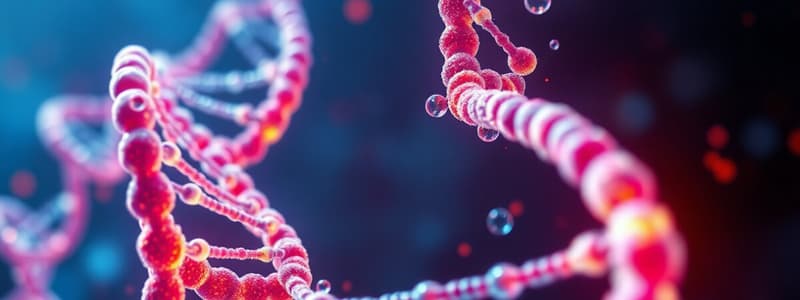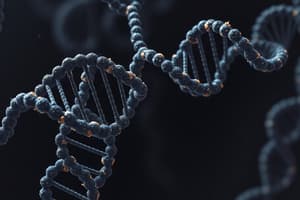Podcast
Questions and Answers
What role do ribozymes play in molecular biology?
What role do ribozymes play in molecular biology?
Which structural feature differentiates RNA from DNA concerning sugars?
Which structural feature differentiates RNA from DNA concerning sugars?
What is a significant reason for the instability of RNA compared to DNA?
What is a significant reason for the instability of RNA compared to DNA?
Which of the following statements regarding nucleotides in RNA and DNA is correct?
Which of the following statements regarding nucleotides in RNA and DNA is correct?
Signup and view all the answers
In what way can RNA demonstrate structural versatility?
In what way can RNA demonstrate structural versatility?
Signup and view all the answers
What role does the terminator play in the transcription unit?
What role does the terminator play in the transcription unit?
Signup and view all the answers
How are nucleotides numbered in relation to the transcription start site?
How are nucleotides numbered in relation to the transcription start site?
Signup and view all the answers
In which direction does RNA synthesis occur during transcription?
In which direction does RNA synthesis occur during transcription?
Signup and view all the answers
Which strand of DNA serves as the template during RNA transcription?
Which strand of DNA serves as the template during RNA transcription?
Signup and view all the answers
What is a distinguishing feature of RNA synthesis compared to DNA synthesis?
What is a distinguishing feature of RNA synthesis compared to DNA synthesis?
Signup and view all the answers
What is the primary role of the sigma factor in bacterial RNA polymerase function?
What is the primary role of the sigma factor in bacterial RNA polymerase function?
Signup and view all the answers
Which of the following statements accurately describes bacterial RNA polymerase?
Which of the following statements accurately describes bacterial RNA polymerase?
Signup and view all the answers
What types of RNA does RNA polymerase I transcribe in eukaryotic cells?
What types of RNA does RNA polymerase I transcribe in eukaryotic cells?
Signup and view all the answers
How many distinct types of RNA polymerases are typically found in eukaryotic cells?
How many distinct types of RNA polymerases are typically found in eukaryotic cells?
Signup and view all the answers
Which of the following is NOT a function of RNA polymerase II in eukaryotic cells?
Which of the following is NOT a function of RNA polymerase II in eukaryotic cells?
Signup and view all the answers
During transcription initiation in bacteria, when does the sigma factor typically detach?
During transcription initiation in bacteria, when does the sigma factor typically detach?
Signup and view all the answers
What does eukaryotic RNA polymerase IV primarily transcribe?
What does eukaryotic RNA polymerase IV primarily transcribe?
Signup and view all the answers
Why are eukaryotic RNA polymerases considered multimeric enzymes?
Why are eukaryotic RNA polymerases considered multimeric enzymes?
Signup and view all the answers
Which type of RNA does RNA polymerase III transcribe in eukaryotic cells?
Which type of RNA does RNA polymerase III transcribe in eukaryotic cells?
Signup and view all the answers
Ribozymes are RNA molecules that could catalyze specific biochemical reactions.
Ribozymes are RNA molecules that could catalyze specific biochemical reactions.
Signup and view all the answers
Thymine is found in RNA as one of its nucleotide bases.
Thymine is found in RNA as one of its nucleotide bases.
Signup and view all the answers
RNA is generally more stable than DNA due to its structural components.
RNA is generally more stable than DNA due to its structural components.
Signup and view all the answers
DNA nucleotides contain ribose sugars, while RNA nucleotides contain deoxyribose sugars.
DNA nucleotides contain ribose sugars, while RNA nucleotides contain deoxyribose sugars.
Signup and view all the answers
RNA is usually double-stranded, while DNA consists of a single polynucleotide strand.
RNA is usually double-stranded, while DNA consists of a single polynucleotide strand.
Signup and view all the answers
Ribosomal RNA (rRNA) is a component of the ribosome, which is the site of protein synthesis.
Ribosomal RNA (rRNA) is a component of the ribosome, which is the site of protein synthesis.
Signup and view all the answers
Pre-messenger RNAs (pre-mRNAs) are created during transcription in prokaryotic cells.
Pre-messenger RNAs (pre-mRNAs) are created during transcription in prokaryotic cells.
Signup and view all the answers
Messenger RNA (mRNA) is usually double-stranded, unlike DNA.
Messenger RNA (mRNA) is usually double-stranded, unlike DNA.
Signup and view all the answers
The sugar present in RNA is deoxyribose, while DNA contains ribose.
The sugar present in RNA is deoxyribose, while DNA contains ribose.
Signup and view all the answers
RNA molecules are generally more stable than DNA molecules.
RNA molecules are generally more stable than DNA molecules.
Signup and view all the answers
Study Notes
RNA Structure
- Ribozymes are RNA molecules that can catalyze biochemical reactions, including RNA splicing in gene expression.
- RNA contains ribose sugar while DNA contains deoxyribose sugar.
- RNA is usually single-stranded, while DNA has two strands joined by hydrogen bonding.
- Thymine in DNA is replaced by uracil in RNA.
Transcription Unit
- The transcription unit is a segment of DNA that is transcribed into RNA.
- The transcription unit includes a promoter, the RNA-coding sequence, and a terminator.
- The promoter is a DNA sequence where RNA polymerase binds.
- The terminator is a DNA sequence that signals the end of transcription.
Upstream and Downstream
- Upstream refers to the region of DNA that is before the start site of transcription.
- Downstream refers to the region of DNA after the start site of transcription.
- The transcription apparatus moves downstream along the DNA as transcription takes place.
Transcription Start Site
- The first nucleotide of the RNA-coding sequence is numbered +1.
- Nucleotides upstream of the start site are assigned negative numbers.
- Nucleotides downstream of the start site are assigned positive numbers.
The Substrate for Transcription
- RNA is synthesized in the 5'-3' direction.
- The sequence of the RNA molecule is complementary and antiparallel to the DNA template strand.
- Unlike DNA synthesis, RNA synthesis does not require a primer.
Bacterial RNA Polymerase
- Bacterial cells typically have one type of RNA polymerase that synthesizes all classes of RNA.
- RNA polymerase is a large, multimeric enzyme.
- It consists of a core enzyme and a sigma factor.
- The sigma factor controls the binding of RNA polymerase to the promoter.
Eukaryotic RNA Polymerase
- Eukaryotic cells have three distinct types of RNA polymerase:
- RNA polymerase I transcribes large rRNA.
- RNA polymerase II transcribes pre-mRNA, snoRNAs, miRNAs, and some snRNAs.
- RNA polymerase III transcribes tRNAs, small rRNA, and some snRNAs.
- All eukaryotic polymerases are large, multimeric enzymes.
The Process of Bacterial Transcription
- Transcription is divided into three stages: initiation, elongation, and termination.
- Initiation: The transcription apparatus assembles on the promoter and begins the synthesis of RNA.
- Elongation: RNA polymerase unwinds the DNA and adds new nucleotides to the 3' end of the growing RNA strand.
- Termination: The transcription unit is recognized, the RNA molecule separates from the DNA template, and RNA polymerase detaches.
Initiation
- The sigma factor associates with the core enzyme to form a holoenzyme, which binds to the –35 and –10 consensus sequences in the DNA promoter.
- The holoenzyme unwinds the DNA to produce a single-stranded template.
- RNA polymerase pairs the base on a ribonucleoside triphosphate with its complementary base at the start site on the DNA template strand.
Elongation
- RNA polymerase undergoes a conformational change and releases the sigma subunit.
- Transcription takes place within a short stretch of about 18 nucleotides of unwound DNA called the transcription bubble.
- RNA polymerase unwinds the DNA ahead of the bubble and rewinds the DNA behind the bubble.
Termination
- RNA polymerase adds nucleotides to the 3' end of the growing RNA molecule until it transcribes a terminator.
- Terminators are usually found upstream of the termination site.
- At the terminator, RNA polymerase stops synthesizing RNA, the RNA molecule is released from RNA polymerase, the newly made RNA molecule detaches from the DNA, and RNA polymerase detaches from the DNA template.
Bacterial Terminators
- There are two major types of bacterial terminators.
Structure of RNA
- RNA is similar to DNA but differs in several key features:
- RNA contains uracil instead of thymine
- RNA is single-stranded, while DNA has two strands joined by hydrogen bonds
- In RNA, ribose sugar has a free hydroxyl group on the 2’ carbon, making RNA degrade rapidly in alkaline conditions
- DNA is more stable due to deoxyribose sugar lacking the free hydroxyl group
- Ribozymes are catalytic RNA molecules that play crucial roles in cellular processes like RNA splicing.
Classes of RNA
- Cellular RNA plays diverse roles:
- Ribosomal RNA (rRNA) along with ribosomal proteins forms the ribosome, responsible for protein synthesis
- Messenger RNA (mRNA) carries coding instructions from DNA to the ribosome, guiding protein synthesis
- Transfer RNA (tRNA) facilitates the incorporation of amino acids into a polypeptide chain during translation
- Additional classes of RNA are found in eukaryotes:
- Small nuclear RNA (snRNA) processes pre-mRNA
- Small nucleolar RNA (snoRNA) processes and assembles rRNA
- MicroRNA (miRNA) inhibits the translation of mRNA
- Small interfering RNA (siRNA) triggers the degradation of other RNA molecules
The concept of Transcription
- Transcription is the process of synthesizing RNA from a DNA template.
- Unlike replication where the entire DNA molecule is copied, transcription only transcribes specific regions of DNA.
- Transcription is a highly selective process, ensuring only the necessary genes are expressed.
- Transcription involves three essential components:
- DNA template
- Raw materials for RNA synthesis
- Transcription apparatus, containing proteins that catalyze RNA synthesis
The Template for Transcription
- Only one strand of the DNA double helix acts as the template for RNA synthesis, known as the template strand.
- The non-template strand (coding strand) is not directly copied into RNA and its sequence resembles the RNA transcript.
- The RNA transcript is complementary and antiparallel to the DNA template strand.
- The RNA transcript has the same sequence as the non-template strand, except uracil (U) replaces thymine (T).
The Transcription Unit
- A transcription unit is the segment of DNA that encodes an RNA molecule, containing three parts:
- Promoter: DNA sequence that binds the transcription apparatus, indicating the start site and direction of transcription.
- RNA-coding region: DNA sequence copied into RNA molecule.
- Terminator: DNA sequence that signals the end of transcription.
- Upstream and downstream terms describe the direction of transcription:
- Upstream refers to sequences located before the start site towards the promoter.
- Downstream refers to sequences located after the start site towards the terminator.
The Substrate for Transcription
- Nucleotides are added to the 3' end of the RNA molecule, making RNA synthesis occur in the 5' to 3' direction.
- RNA synthesis is complementary and antiparallel to the DNA template strand.
- Unlike DNA synthesis, RNA synthesis does not require a primer.
The Transcription Apparatus
- RNA polymerase is the primary enzyme responsible for all steps of transcription:
- Binding to the promoter
- Unwinding DNA
- Synthesizing RNA
- Terminating transcription
- Releasing RNA
Studying That Suits You
Use AI to generate personalized quizzes and flashcards to suit your learning preferences.
Related Documents
Description
This quiz explores the fascinating structure of RNA and the mechanics of transcription. You'll learn about ribozymes, the differences between RNA and DNA, and key elements of the transcription unit. Test your understanding of upstream and downstream sequences as well as transcription start sites.




